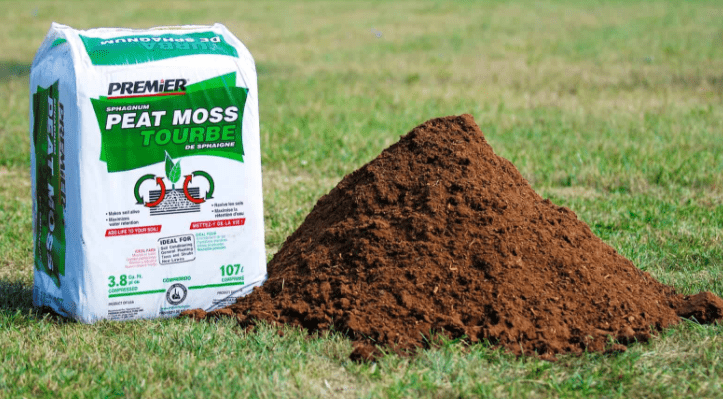Most lawn grasses do best in slightly acidic soil with a pH value between 5.8 and 7.0. When the lawn soil pH is too high, grasses will have a problem absorbing nutrients. Fortunately, various amendments can help acidify soil for proper lawn growth.
To lower soil pH, you can use sphagnum peat, elemental sulfur, aluminum sulfate, acidifying fertilizers, well-decomposed compost, and organic mulches.

How to Lower Soil pH on your Lawn
Before you do any amendments, begin by conducting a soil pH test. You can use a DIY self-test kit or take a sample of your soil to a nearby agricultural extension service.
Based on the recommendations of your soil test, you may acidify the soil using one of the following ingredients:
1. Sphagnum Peat
For small gardens or lawns, sphagnum peat moss is a great addition for lowering soil pH. Add a 1 to 2-inch layer of sphagnum peat and work it into the top 8 to 12 inches of soil before planting your seed.
In a large area, the amount of sphagnum peat to use will be very expensive and thus not a viable option – explains Iowa State University Extension.
2. Elemental Sulfur
Elemental sulfur is the next great alternative that is less expensive. Sulfur, however, requires some time to convert to sulfuric acid with the aid of soil bacteria. This conversion rate also depends on the fineness of the sulfur, soil temperature, and the amount of moisture in the soil.
Depending on these factors, elemental sulfur will take four to six months for you to achieve a reduced soil pH.
Spread elemental sulfur over your lawn with a lawn spreader. For optimal results, Clemson University explains the amount to apply as follows:
On loamy soil apply the elemental sulfur at the rate of 2 pounds per 100 square feet – this will reduce soil pH by one point. On sandy soil, apply 1.4 pounds per 100 square feet. Clay soil will require 2.5 pounds per 100 square feet.
3. Iron Sulfate
Iron sulfate is a faster-acting alternative to elemental sulfur, it changes soil pH in as less as three to four weeks.
Experts at the University of Minnesota recommend applying iron sulfate on loamy and sandy soils at the rate of 4.8 pounds per 100 square feet to achieve a one-point reduction in soil pH. For silty clay soil, increase the rate to 19.2 pounds per 100 square feet.
Excessive levels of iron sulfate or any other soluble salt like aluminum sulfate can stunt turf grasses. To prevent this from happening, divide the recommended amount of the compound into three equal parts.
Apply the first part immediately, and the other two parts at 30-day intervals.
4. Aluminum Sulfate
Aluminum sulfate and iron sulfate produce acidity as soon as it dissolves in the soil thus the best for instantly lowering soil pH to acidic. For this reason, most people use these two elements as compared to elemental sulfur.
However, aluminum sulfate and iron sulfate should be applied at a 5 to 6 times greater making it a big budget.
Do not over-apply above 5 pounds per 100 square feet of aluminum or iron sulfate at any one time. In excess amounts, these two sulfates are harmful to plants. Work into the soil after application for the salts to be more effective.
Aluminum sulfate and iron sulfate should be washed off the leaves immediately after the application to prevent leaf burn.
5. Acidifying fertilizers
Some types of fertilizers can help to lower soil pH over time. Acidifying fertilizers include ammonium sulfate, ammonium nitrate, di-ammonium phosphate, mono-ammonium phosphate, and urea. They are safe to use as long as you read the label on how to use them.
6. Well-decomposed Compost
The addition of a well-decomposed compost helps lower the pH of soil over time. Topdressing your lawn each season with compost is a safe and natural way to make your soil more acidic.
Compost is rich in organic matter that also improves the soil structure and adds beneficial micro-organisms into the soil.
7. Organic Mulches
Adding organic mulch such as coffee grounds in your lawn and garden beds will help in lowering soil alkalinity. The material will break down over time and in the process help in increasing the acidity of the soil.
Other mulches you can use include pine needles or oak leaves. Organic mulches are also beneficial in other ways, such as reducing soil erosion, regulating soil temperature, retaining soil moisture, and releasing beneficial nutrients into the soil.
Final Thought
Testing your soil every season for pH change is an important step for growing healthy plants in your gardens and lawns. You can use a soil test kit for this purpose or take a soil sample to a nearby agricultural extension office.
References
- Wisconsin Horticultural Extension: Reducing Soil pH
- Iowa Sate University Extension: How to Change your Soil’s pH
- Michigan State University Extension: Lowering the Soil pH with Sulfur
- Utah State University Extension: Solutions to Soil Problems II. High pH